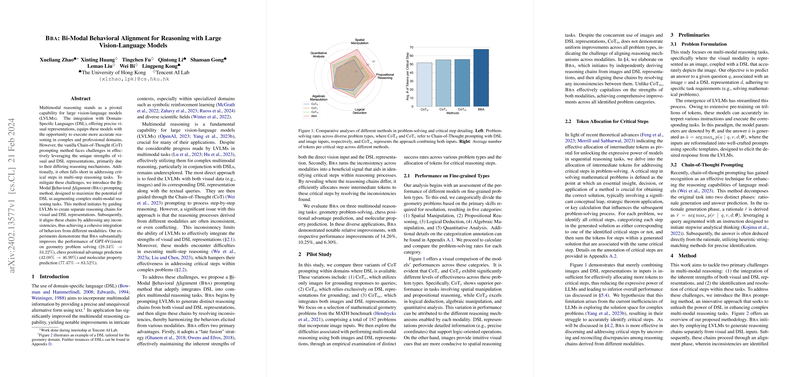Enhancing Multimodal Reasoning in LVLMs Through Bi-Modal Behavioral Alignment
Introduction to Bba Methodology
Multimodal reasoning within large vision-LLMs (LVLMs) holds paramount importance for applications requiring complex domain-specific tasks. These include geometry problem-solving, chess positional advantage predictions, and molecular property predictions, among others. Traditional approaches, including the Chain-of-Thought (CoT) method, have aimed to utilize both visual and domain-specific language (DSL) representations to guide LVLMs through reasoning processes. Nonetheless, integrating these modalities effectively has posed significant challenges, primarily due to inconsistencies in reasoning mechanisms and difficulties in multi-step reasoning tasks. Addressing these limitations, this paper introduces the Bi-Modal Behavioral Alignment (Bba) prompting method, which significantly enhances performance in multimodal reasoning tasks by fostering a cohesive integration of visual and DSL representations.
Challenges in Multimodal Reasoning with LVLMs
The integration of DSL representations with LVLMs has been shown to significantly improve reasoning accuracy in complex domains. However, direct application of CoT prompting with both visual data and DSL representations often results in inconsistencies and limits the models' effectiveness. The Bba method innovates on this front by initially guiding LVLMs to generate distinct reasoning chains for both visual and DSL inputs, followed by an alignment process to resolve any inconsistencies, thereby facilitating a harmonious blend of multimodal information.
Bba Methodology
Bi-Modal Behavior Eliciting
Bba's first phase focuses on independently eliciting reasoning chains from both vision and DSL inputs, leveraging the inherent strengths of each modality. This decoupling allows for the maximization of information utility, where vision-based reasoning excels in spatial manipulation and DSL-based reasoning in logical deduction and precise computation.
Behavior Alignment
The subsequent phase involves diagnosing and aligning the reasoning chains, identifying and addressing inconsistencies, and thus, integrating the strengths of each modality. This alignment not only exploits the advantages of both modalities but also assists in pinpointing critical steps in reasoning processes, ultimately improving LVLMs' performance in complex multi-modal reasoning tasks.
Experimental Evaluation and Results
Bba demonstrated considerable improvements across different tasks: 14.26% in geometry problem-solving, 10.25% in chess positional advantage prediction, and 6.30% in molecular property prediction. These results were notably superior to those obtained using other variants of CoT prompting and baseline methods. Such enhancements underscore Bba's efficacy in leveraging multimodal inputs and its capacity to navigate the complexities of multi-step reasoning with greater accuracy and consistency.
Implications and Future Directions
The Bba method not only advances the field of multimodal reasoning within LVLMs but also opens new avenues for research in integrating diverse data modalities. Looking forward, further exploration into other domains lacking custom DSLs, as well as incorporating feedback from environmental interactions, presents intriguing prospects for evolving LVLM capabilities. Additionally, adapting Bba to work with alternative representations, such as scene graphs, could broaden applicability and facilitate advancements in domains requiring nuanced interpretation of visual information.
Conclusion
Through the implementation of the Bi-modal Behavioral Alignment method, this paper showcases a significant leap in addressing the complexities of multimodal reasoning tasks within large vision-LLMs. Bba's introduction serves as a vital step toward more effectively capitalizing on the strengths of both visual and DSL representations, paving the way for more intelligent and capable multimodal reasoning systems in the future.
